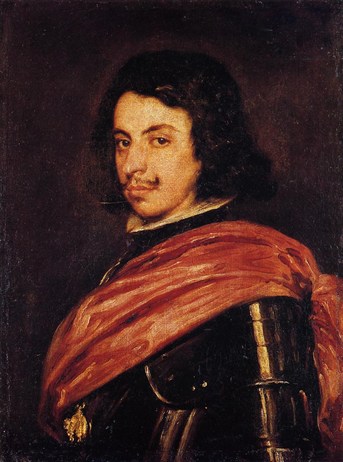The portrait of Francesco I, Duke of Modena
 The Estense Gallery in Modena possesses the Portrait of Duke Francesco I d’Este, executed by the greatest painter of the Spanish Siglo de Oro: Diego Rodríguez de Silva y Velázquez. The Sevillian arrived in Madrid in 1622 and became the court painter to Philip IV of Habsburg. He evinced, since the outset, a sincere interest in the naturalism of Caravaggio and inspiration for still life, as can be seen in the Water-carrier of Seville (1620 ca., London, Wellington Museum). Even his early paintings are conceived of as scenes of daily life, with ample space given to secondary characters and the description of objects. It was at the suggestion of Pieter Paul Rubens, on a diplomatic mission at the court of Madrid in 1628, that Velázquez made his first study trip to Italy. His portraits of rulers, scholars and ordinary people have always received an enthusiastic welcome: the portraits of Philip IV and his brother CharlesCharles of Habsburg (1607-1632) was the fifth son of King Philip III of Spain (1578-1621) and Margaret of Austria-Styria (1584-1611). A direct heir of his elder brother Philip IV (1605-1665) until the birth of the infante Baltasar Carlos (1629-1646), Carlos owes his fame mainly to the magnificent portrait of him that Diego Velázquez made, which is now in the Museo del Prado. are characterized by a realism and elegance that has no equal in the works of contemporary painters. After the Italian stay the master began to insert elements of refinement hitherto unknown, while maintaining the realistic vein and the ability to portray the soul of the sitter.
The Estense Gallery in Modena possesses the Portrait of Duke Francesco I d’Este, executed by the greatest painter of the Spanish Siglo de Oro: Diego Rodríguez de Silva y Velázquez. The Sevillian arrived in Madrid in 1622 and became the court painter to Philip IV of Habsburg. He evinced, since the outset, a sincere interest in the naturalism of Caravaggio and inspiration for still life, as can be seen in the Water-carrier of Seville (1620 ca., London, Wellington Museum). Even his early paintings are conceived of as scenes of daily life, with ample space given to secondary characters and the description of objects. It was at the suggestion of Pieter Paul Rubens, on a diplomatic mission at the court of Madrid in 1628, that Velázquez made his first study trip to Italy. His portraits of rulers, scholars and ordinary people have always received an enthusiastic welcome: the portraits of Philip IV and his brother CharlesCharles of Habsburg (1607-1632) was the fifth son of King Philip III of Spain (1578-1621) and Margaret of Austria-Styria (1584-1611). A direct heir of his elder brother Philip IV (1605-1665) until the birth of the infante Baltasar Carlos (1629-1646), Carlos owes his fame mainly to the magnificent portrait of him that Diego Velázquez made, which is now in the Museo del Prado. are characterized by a realism and elegance that has no equal in the works of contemporary painters. After the Italian stay the master began to insert elements of refinement hitherto unknown, while maintaining the realistic vein and the ability to portray the soul of the sitter.
The portrait of Modena was done in Madrid in 1639, during Francesco IFrancesco I d’Este (1610-1658) was Duke of Modena and Reggio from 1629 until his death. The eldest son of Alfonso III d’Este, he was a skilled leader, ready to take advantage of the contrasts between Spain and France. He was able to add Correggio to his possessions, but failed to recover Ferrara and remove it from the power of the popes. A patron of artists and writers, he transformed his capital, Modena, into one of the most beautiful Italian cities. The portrait that Diego Velázquez made of him is famous.‘s stay there. The Duke was accompanied by Count Fulvio Testi, writer and politician, who celebrated the talent of Velázquez and the beauty of the work in a letter. There is a Portrait of the Count (Modena, Estense Gallery), which is the work of Ludovico Lana. The work captures the moral quality of his personality, with piercing and inquisitive eyes and great precision in the description of the gown and accessories. Francesco I was received with great honours and stayed in the palace of Buen Retiro, beautifully decorated with frescoes and paintings. In Testi’s letters to the court of Modena we learn that the painter “is expensive, but he does well in being so”, and that probably the initial idea was to request an imposing equestrian portrait. The portrait that is now in the Estense Gallery was supposed to represent the model in miniature, captured live for the equestrian portrait, but it was never completed. The Spanish painter managed to express the attitude of the aristocratic prince in the slightly pouting mouth. There is a certain tension: there is almost a hint of suspicion in his gaze, while the stiffness of the pose makes him an archetype of a certain human attitude, still valid to this day. In representing him as a warrior, Velázquez relied on Renaissance models, especially Titian: the Duke decked out in armour dons the Golden Fleece, granted to him by Philip IV. It is a quick portrait, with that unfinished nature of his mature works, which, despite the apparent sketches, are able to render the character of the subject with great intensity.
